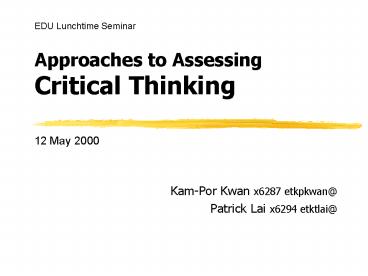Approaches to Assessing Critical Thinking - PowerPoint PPT Presentation
1 / 20
Title:
Approaches to Assessing Critical Thinking
Description:
12 May 2000: Approaches to Assessing Critical Thinking ... Analyticity. CT Self confidence. Cognitive maturity. Truth-seeking. 9. Critical thinking skills ... – PowerPoint PPT presentation
Number of Views:33
Avg rating:3.0/5.0
Title: Approaches to Assessing Critical Thinking
1
Approaches to Assessing Critical Thinking
EDU Lunchtime Seminar
12 May 2000
- Kam-Por Kwan x6287 etkpkwan_at_
- Patrick Lai x6294 etktlai_at_
2
Seminar series
- 12 May 2000 Approaches to Assessing Critical
Thinking - 18 May 2000 Overcoming the Challenges in
Developing Students Critical Thinking - 9 June 2000 Measuring Students Critical
Thinking Problems and Possible Solutions
3
Outline of todays session
- Overview of approaches to assessing critical
thinking (CT) - Examples
- Relative advantages and disadvantages
- Appropriateness for different purposes of CT
assessment - Applicability to your context
- PolyU Special Interest Group for Teaching and
Assessing CT
4
Purposes of CT assessments
- Programme/subject evaluation evidence of success
in promoting CT - Authentic assessment
- evidence of effectiveness of CT instruction
- motivating students to be better at CT
- Diagnostic feedback on students CT level
- for designing instruction
- for faciliating students growth development
- Research into CT instructions
- Selecting students for admission
5
Definition of CT
- Ennis (1993 180) Critical thinking is
reasonable reflective thinking focused on
deciding what to believe or do - APA Delpi Report (1990) Critical thinking is
the process of purposeful, self-regulatory
judgement. This process gives reasoned
consideration to evidence, contexts,
conceptualisations, methods and criteria.
6
Deciding what to believe or do
- Judge the credibility of sources
- Identify conclusions, reasons, and assumptions
- Judge the quality of an argument acceptability
of its reasons, assumptions, and evidence - Develop and defend an issue
- Ask appropriate clarification questions
- Plan experiments amd judge experimental designs
- Define terms in a way appropriate for the context
- Be open-minded
- Try to be well-informed
- Draw conclusions when warranted, but with caution
7
CT Dispositions and skills
- Two components of critical thinking (Facione ,
1996) - Affective dispositions the necessary attitudes
and habits in approaching problems, questions,
and issues for CT to take place - Cognitive skills the mental ability needed for
critical thinking
8
Critical thinking dispositions
Open-mindedness
Inquisitiveness
Systematicity
Dispositions towards CT
Analyticity
Cognitive maturity
Truth-seeking
CT Self confidence
9
Critical thinking skills
Inference
Analysis
Explanation
CT Skills
Interpretation
Evaluation
Self-regulation
Source Facione (1996)
10
Approaches to CT assessments
- Students self-reported skills / gains in CT
- Students performance on standardised published
CT tests - Instructor-constructed CT tests
- Student interviews / protocol analysis
- Students performance on tasks requiring CT
skills - performance assessment
- rubric for assessing CT in students work
11
Self-reported skills /gains in CT
- Students self reports on
- skills in CT
- gains or progress in CT skills
- Examples
- Items from CSEQ
- Items from IDEA
- Relatively easy and inexpensive to use
- Less reliable and valid
12
Published CT tests
- Standardised tests with well-established
psychometric properties - Examples
- The California Critical Thinking Test College
level (CCTST) - Cornell Critical Thinking Test, Level Z (1985)
- Watson-Glaser Critical Thinking Appraisal (1980)
- Reliability and validity established , often with
norms for comparison - Expensive to use, non subject-specific, implicit
cultural and contextual assumptions
13
Instructor-constructed CT tests
- Developed by instructor
- Can be tailored for specific subject, context, or
purpose - Relatively costly to design (both in time and
effort), reliability and validity need to be
determined, difficult to compare across groups or
contexts
14
Interview or protocol analysis
- Students given a problem to solve in an interview
- to find out ways person understands a concept or
solves a problem - Researcher analyses students explanation, and
infers from that to form the researchers
description - Result consists of categories which describe
different ways of understanding a concept or
solving a problem - These categories stand in a logical hierarchical
relationship with one another and have
implications for teaching
15
Interview method
- Students given a problem to solve in an interview
- They are asked to think aloud and tell the
interviewer their thoughts as they are going
through - Probing/Prompted questions
- You mentioned about X. How does this occur?
- Do these symbols have any meaning to you?
- Why did you give up your original hypothesis?
16
Protocol / data analysis
- Verbatim transcription of audio-taped interviews
- Transcription printed and read through with a
particular research question in mind - Descriptive words or phrases attached to short
sections of the transcript as a potential
category - Sections of the transcript that could fit into
this potential category labelled by
sub-categories - Content of one excerpt compared and contrasted
with the content of another similarly labelled
excerpt - Labelled excerpt organised into flow charts.
17
Performance assessments
- Students written and / oral descriptions
analysed by the Holistic Critical Thinking
Scoring Rubric (HCTSR) (Facione and Facione,
1994) - HCTSR measures
- critical thinking skills to reach a judicious
judgment which include analysis, interpretation,
evaluation, inference, explanation - assesses dispositions to pursue reasons and
evidence fair mindedly and open-mindedly to reach
sound, objective decision - HCTSR consists of four levels - level 4 signifies
a critical thinker
18
Assessing CT under the 3-P model
19
CT Assessment for different purposes
20
SIG for teaching assessing CT
- Sharing of resources and experiences in teaching
and assessing CT through - e-newsletter
- regular meetings
- Collaboration in designing and evaluating CT
instructions - trying out innovative methods for CT instruction
- small-scale classroom research
- Contact persons
- Patrick Lai etktlai_at_polyu.edu.hk x6294
- K. P. Kwan etkpkwan_at_polyu.edu.hk x6287

